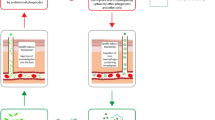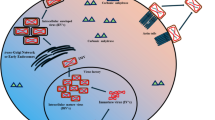Abstract
A monoclonal antibody generated against synthetic peptides patterned on amino acids 542–555 of human band 3, designated 1F4, specifically immunostainedPlasmodium falciparum-infected erythrocytes and inhibited the cytoadherence ofP. falciparum-infected erythrocytes to C32 amelanotic melanoma cells. 1F4 did not recognize intact band 3 protein on immunoblots, however it was reactive towards proteolytic fragments of band 3.
The binding region of another murine monoclonal antibody previously reported to recognize the membrane spanning domain of human band 3, designated B6, was found to also recognize residues 542–555, however its properties differed from 1F4. Mab B6 recognized both infected and uninfected red cells, and reacted only with intact band 3 on immunoblots. Mab B6 was without effect on cytoadherence.
These results demonstrate that monoclonal antibodies reactive against a common peptide sequence may bind to different conformations of the peptide sequence and suggest that the adherent competency ofP. falciparum-infected erythrocytes may result from a change in the surface topography of human band 3 protein.
Similar content being viewed by others
Abbreviations
- ELISA:
-
Enzyme-Linked Immunosorbent Assay
- KLH:
-
Keyhole Limpet Hemocyanin
- PBS:
-
Phosphate Buffered Saline
- Mab:
-
Monoclonal Antibody
- PMSF:
-
Phenylmethyl sulfonyl fluoride
- i.p.:
-
intraperitoneum
- TBS:
-
Tris Buffered Saline
- H2DIDS:
-
dihydro 4,4′-diisothocyanostilbene-2,2′-disulfonic acid
- DIDS:
-
4,4′-diisothiocyanostilbene-2,2′-disulfonic acid
References
Howard RJ, Barnwell JW: Roles of surface antigens on malaria-infected red blood cells in evasion of immunity. In: J.J. Marchalonis (ed.). Contemporary Topics in Immunobiology. Vol 12 Plenum Press, New York, 1984, pp 127–200
Howard RJ, Barnwell JW, Rock EP, Jeequaye J, Ofori-Adjei D, Maloy WL, Lyon JA, Saul A: Two approximately 300 kilodaltonPlasmodium falciparum proteins at the surface membrane of infected erythrocytes. Mol Biochem Parasitol 27: 207–244, 1988
Howard RJ, Handunnetti S, Hasler T, Gilladoga A, de Aguiar J, Pasloske B, Morehead D, Albrecht G, van Schravendijk M: Surface molecules onPlasmodium falciparum-infected erythrocytes involved in adherence. Am J Trop Med Hyg 43: 15–29, 1990
Winograd E, Sherman IW: Characterization of a modified red cell membrane protein expressed on erythrocytes infected with the human malaria parasitePlasmodium falciparum: possible role as a cytoadherent mediating protein. J Cell Biol 108: 23–30, 1989
Crandall IE, Sherman IW:Plasmodium falciparum (human malaria)-induced modifications in human erythrocyte band 3 protein. Parasitol 102: 335–340, 1991
Kopito RR, Lodish HF: Primary structure and transmembrane orientation of the murine anion exchange protein. Nature (London) 316: 234–238, 1985
Tanner MJA, Martin PG, High S: The complete amino acid sequence of the human erythrocyte membrane anion-transport protein deduced from the cDNA sequence. Biochem J 256: 703–712, 1988
Lux SE, John KM, Kopito RR, Lodish HF: Cloning and characterization of band 3, the human erythrocyte anion-exchange protein (AE1). Proc Natl Acad Sci USA 86: 9089–9093, 1989
Low PS: Structure and function of the cytoplasmic domain of band 3: center of erythrocyte membrane-peripheral protein interactions. Biochim Biophys Acta 864: 145–167, 1986
Trager W, Jensen JB: Human malaria parasites in continuous culture. Science (Washington D.C.) 193: 673–675, 1976
Lambros C, Vanderberg JP: Synchronization ofPlasmodium falciparum erythrocytic stages in culture. J Parasitol 65: 418–420, 1980
Pasvol G, Wilson RJM, Smalley ME, Brown J: Separation of viable schizont-infected cells ofPlasmodium falciparum from human blood. Annal Tropic Med and Parasitol 65: 87–88, 1978
Giuliani A, Ferroni L, Caprari P, Salvati AM: Band 3 purification from erythrocyte membrane: Comparative evaluation of different extraction systems. Clin Chem Enzym Comms 3: 299–312, 1990
Marini S, Citro G, Di Cesare S, Zito R, Giardina B: Production and characterization of monoclonal antibodies against DNA single ring diamine adducts. Hybridoma 7: 193–202, 1988
Harlow E, Lane D: In: E. Harlow, D. Lane (eds). Antibodies: A laboratory manual. Cold Spring Harbor Laboratory, Cold Spring Harbor, New York, 1985, pp 75–77
Crandall IE, Sherman IW: Antibodies to synthetic peptides based on band 3 motifs reacts specifically withPlasmodium falciparum (human malaria)-infected erythrocytes and block cytoadherence. Parasitol 108: 389–396, 1994
Crandall IE, Smith H, Sherman IW:Plasmodium falciparum: The effect of pH and Ca2+ concentration on thein vitro cytoadherence of infected erythrocytes to amelanotic melanoma cells. Exp Parasitol 73: 362–368, 1991
Udeinya IJ, Scmidt JA, Aikawa M, Miller LH, Green I:Falciparum malaria-infected erythrocytes specifically bind to cultured human endothelial cells. Science 213: 555–557, 1981
Dodge JT, Mitchell C, Hanaban DJ: The preparation and chemical characterization of hemoglobin free erythrocytes. Arch Biochem Biophys 100: 119–130, 1963
Wainwright SD, Tanner MJA, Martin GEM, Yendle JE, Holmes C: Monoclonal anibodies to the membrane domain of the human erythrocyte anion transport protein. Biochem J 258: 211–20, 1989
Lowry OH, Rosebrough NJ, Farr AL, Randall RJ: Protein measurement with the folin phenol reagent. J Biol Chem 193: 265–275, 1951
Doucet JP, Trifaro JM: A discontinuous and highly porous sodium dodecyl sulfate polyacrylamide slab gel system of high resolution. Anal Biochem 168: 265–271, 1988
Towbin H, Staehelin T, Gordon J: Electrophoretic transfer of proteins from polyacrylamide gels to nitrocellulose sheets: procedure and some applications. Proc Natl Acad Sci USA 76: 4350–4354, 1974
Blake MS, Johnston KH, Russell-Jones CJ, Gotchich EC: A rapid, sensitive method for detection of alkaline phosphate-conjugated antibody on Western blots. Anal Biochem 136: 175–179, 1984
Giuliani A, Marini S, Ferroni L, Caprari P, Condo SG, Ramacci MT, Giardina B: A monoclonal antibody monitoring band 3 modifications in human red blood cells. Molec Cell Biochem 117: 43–51, 1992
Crandall IE, Sherman IW: Cytoadherence-related neoantigens onPlasmodium falciparum (human malaria)-infected human erythrocytes result from the expression of normally cryptic regions of the band 3 protein. Parasitol 108: 257–267, 1994
Jennings ML, Anderson MP, Monaghan R: Monoclonal antibodies against human band 3 protein. J Biol Chem 261: 9002–9010, 1985
Jay D, Cantley L: Structural aspects of the red cell protein. Annu Rev Biochem 55: 511–538, 1986
Allred DR, Gruenberg JE, Sherman IW: Dynamic rearrangements of erythrocyte internal membrane architecture induced by infection ithPlasmodium falciparum. J Cell Sci 81: 1–16, 1986
Sherman IW, Greenan J:Plasmodium falciparum: regional differences in lectin and cationized ferritin binding to the surface of the malaria infected human erythrocyte. Parasitol 93: 17–32, 1986
Winograd E, Sherman IW: Characterization of a modified red cell membrane protein expressed on erythrocytes infected with the human malaria parasitePlasmodium falciparum: possible role as a cytoadherent mediating protein. J Cell Biol 108: 23–80, 1989
Aikawa M, Atkinson CT: Immunoelectron microscopy of parasites. Adv Parasitol 29: 151–214, 1990
Gormley JA, Howard RJ, Taraschi TF: Trafficking of malarial proteins to the host cell cytoplasm and erythrocyte membrane proteins involves multiple pathways. J Cell Biol 119: 1481–1495, 1992
Pasloske BL, Baruch DL, van Schravendijk MR, Handunnetti SM, Aikawa M, Fujioka H, Taraschi TF, Gormley JA, Howard RJ: Cloning and characterization of aPlasmodium falciparum gene encoding a novel high-molecular weight host membrane-associated protein PfEMP3. Mol Biochem Parasitol 59: 59–72, 1993
Knapp B, Hundt E, Lingelbach KR: Structure and possible function ofPlasmodium falciparum protein exported to the erythrocyte membrane. Parasitol Res 77: 277–282, 1991
Wang DN, Sarabia VE, Reithmeier RA, Kuhlbrandt W: Three-dimensional map of the dimeric membrane domain of the human erythrocyte anion exchanger, Band 3. EMBO J 13(14): 3230–3235, 1994
Wood PG, Muller H, Sovak M, Passow H: Role of Lys558 and Lys869 in substrate and inhibitor binding to the murine band 3 protein: a study of the effects of site directed mutagenesis of the band 3 expressed in the oocytes ofXenopus laevis. J Mem Biol 127: 139–148, 1992
Okubo K, Kang D, Hamasaki N, Jennings ML: Red blood cell band 3. J Biol Chem 269: 1918–1926, 1994
Appell KC, Low PS: Evaluation of structural interdependence of membrane-spanning and cytoplasmic domains of band 3. Biochem 21: 2151–2157, 1982
Jennings ML, Adams-Lackey M, Denney GH: Peptides of human erythrocyte band 3 produced by extracellular papain cleavage. J Biol Chem 259: 4652–4660, 1984
Kang D, Okubo K, Hamasaki N, Kuroda N, Shiraki H: A structural study of the membrane domain of band 3 by tryptic digestion. J Biol Chem 267: 19211–19217, 1992
Sherman IW, Valdez E:In vitro cytoadherence ofPlasmodium falciparum-infected erythrocytes to melanoma cells: factors affecting adhesion. Exp Parasitol 98: 359–369, 1989
Crandall IE, Land KM, Sherman IW:Plasmodium falciparum: Pfalhesin and CD36 form an adhesion/receptor pair that is responsible for the pH-dependent portion of cytoadherence/sequestration. Exp Parasitol 78: 203–209, 1994
Kay MMB: Localization of the senescent cell antigen on band 3. Proc Natl Acad Sci USA 81: 5753–5737, 1984
Lutz HU: In: J.R. Harris (ed.). Blood Cell Biochemistry Vol 1, Erythroid Cells Plenum Press, New York, pp 81–120, 1990
Kay MMB, Marchalonis JJ, Schluter SF, Bosman G: Human erythrocyte aging; cellular and molecular biology. Transf Med Rev 3: 173–195, 1991
Lutz HU, Bussolino F, Flepp R, Fasler S, Stammler P, Kazatchkine MD, Arese P: Naturally occurring anti-band 3 antibodies and complement together mediate phagocytosis of oxidatively stressed human erythrocytes. Proc Natl Acad Sci USA 84: 7368–7372, 1987
Lutz HU, Fasler S, Stammler P, Bussolino F, Arese P: Naturally occurring anti-band 3 antibodies and complement in phagocytosis of oxidatively-stressed and in clearance of senescent red cells. Blood Cells 14: 175–195, 1988
Kay MMB: Molecular mapping of human band 3 aging antigenic sites and active amino acids using synthetic peptides. J Protein Chem 11: 595–602, 1992
Lutz HU, Gianora O, Nater M, Schweizer E, Stammler P: Naturally occurring anti-band 3 antibodies bind to protein rather than to carbohydrate on band 3. J Biol Chem 268: 23562–23566, 1993
Steck TL, Ramos B, Strapazon E: Proteolytic dissection of band 3, the predominant transmembrane polypeptide of the human erythrocyte membrane. Biochem 15: 1154–60, 1976
Wood PG: In: E. Bamberg, H. Passow (eds.). Progress in Cell Research, Vol. 2. The Band 3 Proteins: Anion Transporters, Binding Protein and Senescent Antigens Elsevier Science Publishers, BV Amsterdam, 1992, pp 325–352
Author information
Authors and Affiliations
Rights and permissions
About this article
Cite this article
Guthrie, N., Crandall, I.E., Marini, S. et al. Monoclonal antibodies that react with human band 3 residues 542–555 recognize different conformations of this protein in uninfected andPlasmodium falciparum infected erythrocytes. Mol Cell Biochem 144, 117–123 (1995). https://doi.org/10.1007/BF00944390
Received:
Accepted:
Issue Date:
DOI: https://doi.org/10.1007/BF00944390




